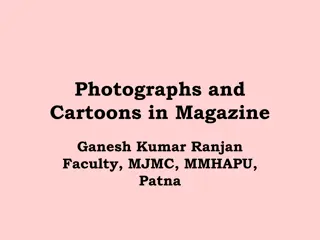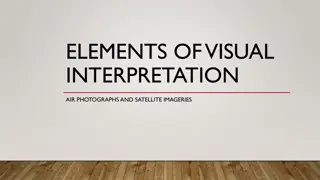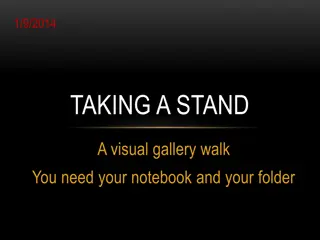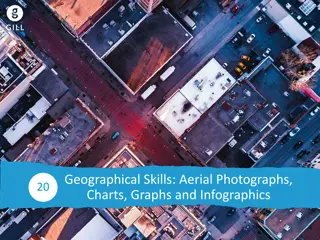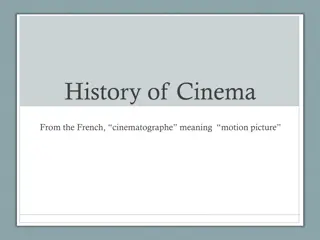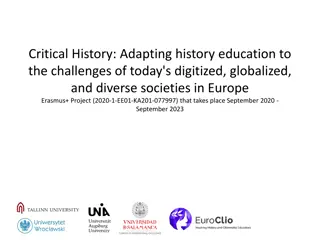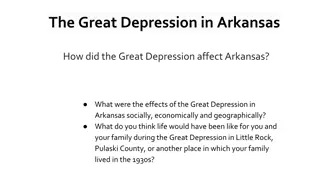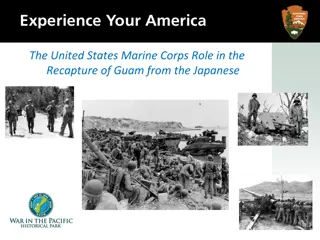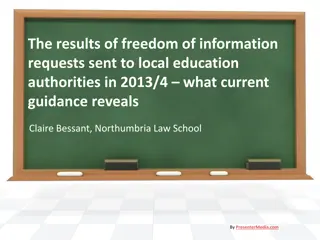Analyzing Documentary Photographs in US History
This assignment explores the impact of documentary photographs on the history of the United States by analyzing compelling images and discussing their context. The power of unaltered images to evoke emotion, drive action, and influence society is highlighted. Through examining specific photographs, students are encouraged to reflect on the historical significance of each image and consider the broader implications.
Uploaded on Oct 06, 2024 | 0 Views
Download Presentation

Please find below an Image/Link to download the presentation.
The content on the website is provided AS IS for your information and personal use only. It may not be sold, licensed, or shared on other websites without obtaining consent from the author. Download presentation by click this link. If you encounter any issues during the download, it is possible that the publisher has removed the file from their server.
E N D
Presentation Transcript
A Picture is Worth a Thousand Words Analyzing Photo Journals and Their Context in History In this assignment you will analyze documentary photographs and discuss their context in the history of the United States. You will evaluate the impact of the media on society. 1
Overview Overview While the expression A picture is worth 1,000 words is meant to convey that an image means more than talk, images can also compel us to volunteer, donate money, vote a certain way, or join a group. Discussion is just the beginning. Some attribute the expression, Un bon croquis vaut mieux qu un long discours, or A good sketch is better than a long speech to emperor Napoleon Bonaparte. Photographs can be even more convincing, especially if they are not altered by digital editing software. Take a look at the following photo. 1. What do you see? 2. How do you feel looking at the image? 3. Why do you think the photographer took the picture? (The caption under the picture describes the photo.) 2
Background Background Photographs can tell us about times and places where we have not been or remind us of details we may not have noticed in a given moment. A photographer, like any artist, can bring his or her own point of view into their work by choosing the setting, repositioning their subject, and even choosing the lighting conditions in which they shoot the picture. All of these choices influence how we see what the photographer wants us to see. Sometimes, the subject is unaware of the impact that the photo being taken can have on others. Often, this is because the experience they are having while being photographed requires all of their attention, such as feeding hungry children, or even walking to school safely. The implications of what the image could become, 10, 50, or 100 years from now are hard to fathom. 3
Guatemalan migrant Engracia Corio, who is waiting for her court hearing for asylum seekers that returned to Mexico to await their legal proceedings under a new policy established by the U.S. government, baths her daughter at a migrant shelter in Ciudad Juarez, Mexico May 17, 2019. Picture taken May 17, 2019. REUTERS/Jose Luis Gonzalez 4
Assignment 1 Assignment 1 Some photographs are so compelling that they can pull in the viewer, evoking emotion and motivating them to act. Study the images on the next slides and read the summaries of each image. Notice the simplicity of each image and think about the historical significance of each image. What happened as a result of the picture being taken and publicized? In the next assignment, you will choose one of the images and answer some questions about the image, so keep that in mind as you look at the images and read the corresponding text. 5
EXAMPLE A: Migrant Mother (1936) EXAMPLE A: Migrant Mother (1936) 6
EXAMPLE A: Migrant Mother (1936) EXAMPLE A: Migrant Mother (1936) In 1936 Dorothea Lange photographed a mother of seven who was a migrant worker. She was following the pea harvest but the ground was frozen, leaving nothing to pick. The mother was housing her family in a lean-to, having just sold the family tent and the tires off the family car. While she was 32 when the image was taken, she appears to be a much older woman. These images were used to document the work of the Resettlement Administration, later called the Farm Security Administration. This image, called Migrant Mother , was immediately published in a San Francisco paper and the federal government sent 20,000 pounds of food to the camp where she was photographed. It is said that it inspired John Steinbeck to write Grapes of Wrath . Lange later said she was drawn to the site after completing her work, and mailing her film back to Washington, DC. She only shot five images, and did not approach anyone but Florence Owens Thompson at the camp. 7
EXAMPLE B: Dorothy Counts (1957) EXAMPLE B: Dorothy Counts (1957) 8
EXAMPLE B: Dorothy Counts (1957) EXAMPLE B: Dorothy Counts (1957) In 1957, fifteen-year-old Dorothy Geraldine Counts and three other students became the first African American students to attend the previously all white Harding High School in Charlotte, North Carolina. They were greeted by angry white mobs that screamed obscenities and racial slurs at the African American students. Counts s picture appeared in many newspapers, as did others of black students attempting to attend white schools for the first time. Counts s family feared for her safety and withdrew her from Harding and sent her to a completely integrated high school in Pennsylvania, after four days of her enduring the taunting. The image, by Douglas Martin for the Associated Press, was the photo of the year in 1957. Later that year, language was added to the decision Brown Vs. Board Of Education that read that communities were to desegregate their schools with all deliberate speed. 9
EXAMPLE C: Robert Kennedy is EXAMPLE C: Robert Kennedy is Assassinated (1968) Assassinated (1968) On June 5, 1968, Robert Kennedy learned that he had been nominated as the democratic candidate for President, just months after the death of his brother, John Fitzgerald Kennedy had been captured on film. It was an assassin s bullet that hit Robert Kennedy just after midnight in the Ambassador Hotel, as he exited the ballroom through the kitchen. While there are theories about whether or not there was one assassin or two, it cannot be disputed that Kennedy was photographed in the arms of a 17-year old bus boy named Juan Romero, a Mexican immigrant who later confessed that he traded tasks with his co-workers to meet his role model that evening. He d been the subject of much discrimination at work, and was inspired by Kennedy s plans for The United States. 10
EXAMPLE C: Robert Kennedy is EXAMPLE C: Robert Kennedy is Assassinated (1968) Assassinated (1968) The politician was bleeding from the head as Romero supported him and offered prayers of comfort to his idol, who died 26 hours later. Bill Eppridge, a photojournalist who was assigned to cover the campaign captured the image. In 2004, Eppridge said, It went through my mind not to take the picture, but this was history. 11
EXAMPLE C: Robert Kennedy is EXAMPLE C: Robert Kennedy is Assassinated (1968) Assassinated (1968) Hubert Humphrey replaced Robert Kennedy as the democratic nominee for President, who was unable to defeat Richard Nixon. After Robert Kennedy s assassination the United States Secret Service provided protection to presidential candidates. 12
EXAMPLE D: The Afghan Girl (1985) EXAMPLE D: The Afghan Girl (1985) 13
EXAMPLE D: The Afghan Girl (1985) EXAMPLE D: The Afghan Girl (1985) In 2002, the face of another woman caught the attention of the world. Sharbat Gula, thought to be 29, was found in the mountains of Pakistan, some 17 years after an image of her piercing green eyes turned the attention of world to the plight of refugees. Known since June 1985 as simply, The Afghan Girl, orphaned at six due to a Soviet bombing, her grandmother led her on foot to various camps in Pakistan. She had never been photographed since that visit (she was 12 in the original photo above), and was surprised that millions had seen her photo. By examining patterns in her irises, the part of the eye that are a brilliant green, an ophthalmologist in Pakistan and a forensic examiner for the Federal Bureau of Investigation in Washington, D.C., confirmed that the girl in the image was Sharbat Gula. Her request to help girls, like her own, to receive a proper education resulted in the founding of a $1,000,000 project now called the Afghan Children s Fund. 14
Assignment 2 Assignment 2 Type your answer here. Type your answer here. Type your answer here. Type your answer here. Type your answer here. Type your answer here. Type your answer here. Type your answer here. Type your answer here. 15
Assignment 2 (continued) Assignment 2 (continued) Type your answer here. Type your answer here. Type your answer here. 16
Assignment 3 Assignment 3 Watch this video of a photographer telling the story of his own work: The Photographs of Gerald Herbert on the Gulf Coast Oil Spill s Effect on Wildlife 17


